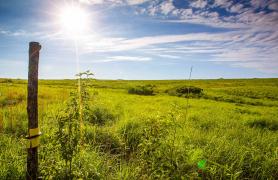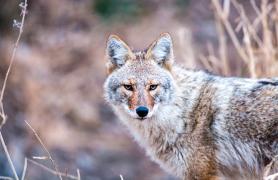
Nature-based preschool takes learning outside
Miss Megan calls out in a voice filled with enthusiasm.
“Are we ready? Let’s put our water bottles in the basket and get our shoes on, everybody!”
Next, Miss Megan lays out a few minimalist rules.
“Frankie… and Christa,” she says to focus some wandering attention, “We’re gonna remember that when we’re going on our adventure, we’re using our fox feet to stay right together. We don’t go too fast, and we don’t go too slow. We stay in our little fox pack, don’t we? We stay right together.”
Then, she leads the excited group down the gentle hill toward a little grove of trees below the preschool. Amid much laughter and talking, the children work together to tow a wagon load of tools and supplies with them. Once they arrive in the woods, it’s time for individual exploration.
“Miss Megan, I saw an orange spider! An’ it was wiggling!” shouts one boy.
“Wow!” she says in reply. The adventure is off to a great start.
Megan Fox, with help from husband Alan Helland and one part-time teacher, runs Forest Kindergarten at Blue Fox Farm, a nature-based preschool in rural Boone County near Ashland. Inside the little building that serves as the preschool’s “base of operations,” the scene resembles preschools all over Missouri, with children’s toys and seating scattered about and a plastic tub with monarch butterfly chrysalises hanging from the lid. But at a nature-based preschool, indoors is not where the action is. During the five-hour school day, Blue Fox Farm children typically spend four of them out in the forest, fields, and creeks on the 70-acre property.
“We’re outside at least three hours, even in the coldest weather,” says Fox. Some of that time is spent running around and making mud pies in a simple playground next to the building, she notes. “For licensing, I have to have a fenced-in play yard. But our focus is going to the woods.”
And this morning, like every morning, the woods is a diverse and fascinating place.
A young girl runs up to Miss Megan with a stick she has found.
“This is my new fishing pole,” she says proudly.
“You’ve got a fishing pole? Great!”
A few moments later, the same girl calls out from her pretend fishing hole.
“I got a fish! I got another fish!”
“You got another fish?” says Miss Megan. “Fry it up for lunch!”
Building a Relationship With Nature
A dozen years ago, you might have counted all the nature-based preschools in the U.S. on your fingers and toes. But in the last decade, the idea of allowing young children to learn and develop in outdoor settings has taken flight, inspired by models in places like Norway, Sweden, Switzerland, and the United Kingdom. Now, according to Christy Merrick of the Natural Start Alliance, an arm of the North American Association of Environmental Education that supports nature-based preschools and similar programs, there are over 650.
What is driving this growth? Partly, it is a growing body of academic research that is revealing a host of benefits from letting kids spend time in the woods. Studies have found that children who spend more hours outdoors demonstrate increased imaginative play, develop better vocabulary and gross motor skills, show reduced symptoms of attention-deficit/hyperactivity disorder (ADHD), have better psychological well-being, and even exhibit a lower incidence of nearsightedness. Perhaps most significant to people who care about conservation, though, is the evidence that connection to nature in young children — fostered by unstructured play in natural settings and supported by interaction with adult mentors — leads to pro-conservation behaviors later in life.
Fox puts it this way: “Early childhood is all about relationships and one of the relationships we often kind of just skip over in traditional education — or just in the society we live in today — is the relationship with the natural world. If we want that relationship to continue, we have to start really early because that’s where the meaning is formed.”
Filling a Natural Need
Over in St. Louis County, Raintree School is bringing a similar outdoor experience to a suburban audience. Located in Town and Country, Raintree School was the first nature-based early childhood education program in Missouri and remains the largest. It boasts over 100 students from two years old through kindergarten and is in the process of extending its programs into the elementary grades.
Like a lot of founders of nature-based programs, President Ilya Eydelman was a parent who couldn’t find an existing preschool that matched his philosophies of how to develop young children.
“My wife and I started the school in 2006 after having searched and searched and searched for early childhood options for our son,” he explains. Initially, they launched their preschool in a former KinderCare building surrounded by asphalt. While they made periodic forays to local natural areas, the idea of creating a truly nature-focused program was inspired at a conference where they learned about a model program developed in Scotland.
“That really opened our eyes. We were always kind of philosophically parallel to that idea, but the whole concept of a forest school hadn’t really gelled for us until we met this group at the summit.”
It led to the creation of their current facility, which opened on a wooded 11-acre site in February 2014.
The Benefits of Failure and Risk Taking
While built upon many of the same philosophies as the forest kindergarten at Blue Fox Farm, Raintree School has adopted a Reggio Emilia approach, named after a child-driven model first developed in an Italian town of that name. One feature of the Reggio-inspired approach is the involvement of groups of children in long-term learning projects they design themselves. Besides requiring relationship-building and teamwork, the project-oriented approach allows for a lot of experiential learning.
“Failure is a big part of what we do,” says Eydelman. “We allow the kids to fail — we don’t tell them, ‘No, that won’t work.’ At one point they tried to make a prosthetic for a deer, a three-legged deer that we have on campus here. You can probably figure how that ended.”
Undeterred by the realization that deer won’t wear prosthetics, the children took a different tack. Surmising that their deer had probably been injured in a collision with a car, they decide to install deer-deterrence devices along a busy local thoroughfare. Over the next several years, they learned about deer-car collisions, found a device manufactured in the United Kingdom, went in front of the Board of Aldermen and County to get it approved, approached the Humane Society to recruit volunteer labor, and turned solving a deer problem into solving a community problem.
The idea of learning through failure extends to the risks inherent in spending time outdoors. Some parents balk at the notion of their young children traipsing around in the woods and fields because they fear ticks, poison ivy, broken bones — or worse. But, just as children learn from failure, notes Eydelman, “We want them to learn through scrapes and bruises.”
“Things happen. Kids get hurt. It’s a fact of life. Being out in the woods does not make that more prevalent,” he says. “You can crack your head open on a nicely rounded steel play set, just like you can on the boulder out there. And yet, if you look at studies, those injuries are much less prevalent on natural playscapes than they are on traditional commercial playscapes.” The reason, he says, is that risk is much more difficult for children to assess in man-made environments, where everything looks smooth and soft. In nature, there are fewer surprises.
Nature-based early childhood educators agree, the benefits of growing up in nature far outweigh the risks. Eydelman puts it this way: “Time and again, unstructured outdoor time has been shown to improve pretty much every metric that you want your child to excel at. Cognitive development, socio-emotional development, academic achievement. There’s something about unstructured outdoor experiences that really gets their brains working the right way.”
That’s all well and good if your children (or grandchildren) have ready access to wild places. But how can city kids benefit from nature-based early childhood education?
“Poop is Always Exciting”
One answer to that question was launched by the Saint Louis Zoo, located in Forest Park in the heart of Missouri’s largest urban area. The Saint Louis Zoo Preschool opened in 2014. Like its fellow Missouri nature-based programs, it spends at least 50 percent of its time outdoors. Much of that occurs on the zoo grounds, but every Friday participants spend the day in nearby natural habitats, including Kennedy Memorial Forest, a wild piece of ground adjoining the zoo and managed by Forest Park Forever (with financial support from MDC). It isn’t pristine wilderness, Preschool Director Laura Seger acknowledges, but that doesn’t matter to a 4-year-old.
“In the park, we find box turtles and aquatic turtles and lots of invertebrates. And then of course we’ll see squirrels and stuff. We found a squirrel’s skull — that was very exciting. That was a big deal. There was a lot of discussion about what that was, and how did it get that way.” She pauses.
“Poop is always exciting. We find poop. We climb trees. We do all that stuff.”
It doesn’t take a big natural area to expose young children to the outdoors, Seger says.
“There’s so many great spaces. There’s so much potential. It really is using what you have, even if it’s just one day a week. There’s so many ways you can do it and connect kids that are easy and free.”
Recognizing the importance of offering opportunities for nature-based learning in the urban environment, zoo leaders are planning to expand programming to a new property recently purchased in Spanish Lake, on the north side of the metro area.
Adventure Awaits
Back at Blue Fox Farm, the morning visit to the forest is winding down, but there are still discoveries to be made. One boy has found a small caterpillar, and has it crawling on his hand. Miss Megan invites other children over to see.
“Do you want to hold the fuzzy guy?” she says to a little girl. “Are you done with him, Arlo?”
“I’m done with him.”
“Would you like to hold him? Put your hand right in front and see if he’ll crawl on.”
“NO-O-O!” says the girl.
“No, you don’t want to? Okay.”
“I just want to touch him,” she says. And she reaches out with a finger.
“So gentle … so gentle,” coaches Miss Megan. “Okay, Arlo says he’s done, so we’re going to put him on a leaf now. Come on, little fuzzy guy.” The caterpillar returns to the woods. Then, the children return to their home base for lunch and a nap. The adventure is over for today.
But tomorrow, another adventure awaits.
























Also In This Issue

Missouri’s quail restoration landscapes

Wildlife damage biologist helps homeowners identify mystery visitors.
And More...
This Issue's Staff
Stephanie Thurber
EDITOR
Angie Daly Morfeld
ASSOCIATE EDITOR
Larry Archer
PHOTOGRAPHY EDITOR
Cliff White
STAFF WRITERS
Bonnie Chasteen
Kristie Hilgedick
Joe Jerek
DESIGNERS
Shawn Carey
Marci Porter
PHOTOGRAPHERS
Noppadol Paothong
David Stonner
CIRCULATION MANAGER
Laura Scheuler






















